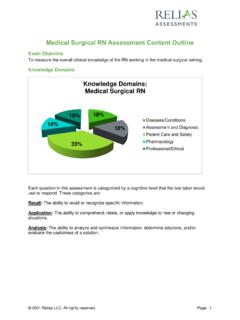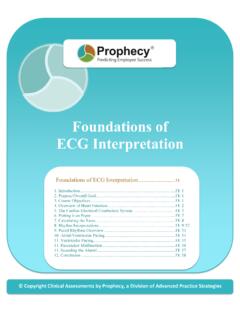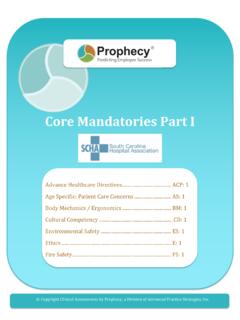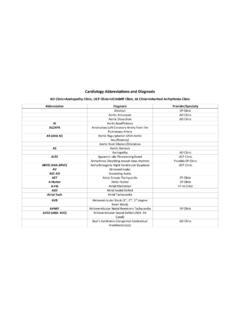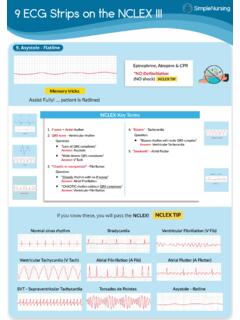Transcription of Prophecy Dysrhythmia with Measurements (ADVANCED) Exam ...
1 Dysrhythmia with Measurement (ADVANCED). Exam Content Outline Exam Objective: To measure the overall level of clinical knowledge in the area of Advanced Interpretation and Measurements . Knowledge Domains - Dysrhythmia with Measurements (ADVANCED). Heart Rate Interpretation 22% 8% 5% 8% PR Interval Measurement QRS Complex Measurement 10% 10% Atrial Heart Blocks 17% 17% Junctional 3% Paced Sinus Ventricular All Strips on the assessment are 6 seconds in length Any unlawful use or reproduction of this data and content will be prosecuted to the fullest extent of the law. I. HR Interpretation A. Knowledge of normal and abnormal components and Measurements of the ECG waveform: 1. QRS duration 2. QRS complex B. Knowledge of normal and abnormal heart rates. C. Knowledge of time intervals on normal ECG paper grid. D. Knowledge of acceptable methods to ensure correct Measurements of ECG waveforms such as calipers.
2 II. PR Interval Interpretation A. Knowledge of normal and abnormal components and Measurements of the ECG waveform: 1. P Wave 2. PR Interval B. Knowledge of normal and abnormal heart rates. C. Knowledge of time intervals on normal ECG paper grid. D. Knowledge of acceptable methods to ensure correct Measurements of ECG waveforms such as calipers. II. QRS Interpretation A. Knowledge of normal and abnormal components and Measurements of the ECG waveform: 1. QRS duration 2. QRS complex T wave B. Knowledge of normal and abnormal heart rates. C. Knowledge of time intervals on normal ECG paper grid. D. Knowledge of acceptable methods to ensure correct Measurements of ECG waveforms such as calipers. Any unlawful use or reproduction of this data and content will be prosecuted to the fullest extent of the law. III. Rhythm Interpretation Sinus A. Normal Sinus Rhythm B. Bradycardia C. tachycardia IV.
3 Rhythm Interpretation Atrial A. Atrial Fibrillation B. Atrial Flutter C. PAC (Premature Atrial Contraction). II. Rhythm Interpretation AV (Atrioventricular) Heart Blocks st A. 1 degree AV Block nd B. 2 degree AV Block Mobitz I. nd C. 2 degree AV Block Mobitz II. rd D. 3 degree AV Block III. Rhythm Interpretation Junctional A. Accelerated Junctional B. Junctional tachycardia C. supraventricular tachycardia (SVT). IV. Rhythm Interpretation Paced V. Rhythm Interpretation Ventricular A. Accelerated Idioventricular B. Idioventricular C. PVC's (Premature Ventricular Contraction). D. PVC's Trigeminy E. Asystole F. Ventricular Fibrillation (VFib). G. Ventricular tachycardia (VTach). H. Sinus Bradycardia with Couplet Any unlawful use or reproduction of this data and content will be prosecuted to the fullest extent of the law. Basic Steps to Rhythm Interpretation 1. Is the rhythm regular or irregular?
4 2. What is the rate? 3. Is the rate too slow or too fast? 4. Is there a P wave for every QRS? 5. Is there a QRS complex for every P. wave? 6. What is the P-R interval? Is it constant? 7. Is the R-R interval regular? 8. What is the QRS duration? 9. Is the QRS wide or narrow? 10. Are the QRS complexes grouped or not grouped? Helpful Resources for Dysrhythmia Review &. Remediation: #AVHB. Any unlawful use or reproduction of this data and content will be prosecuted to the fullest extent of the law.


